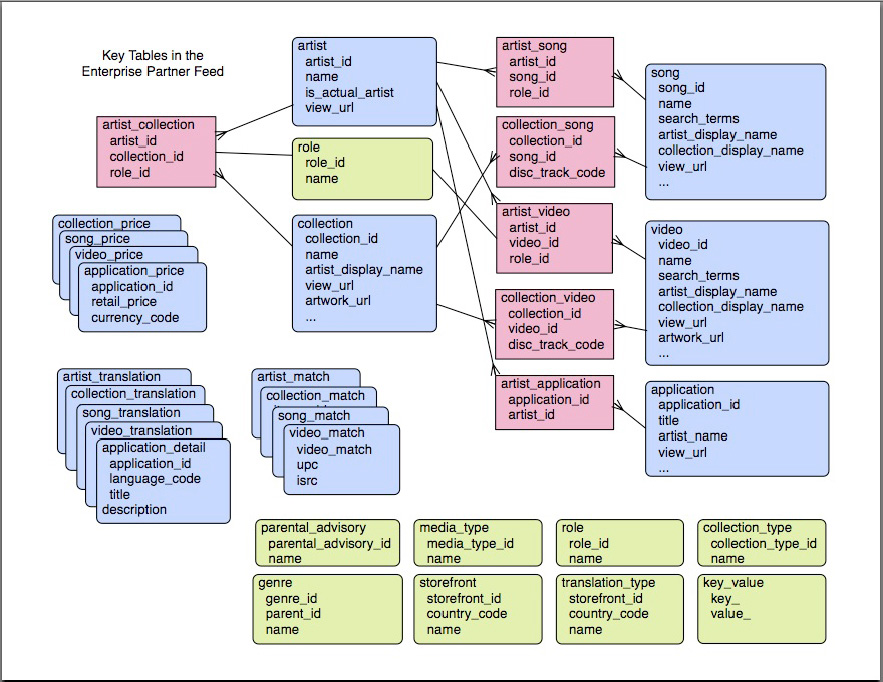
❖ Inside the Enterprise Partner Feed: How SSO Structures Data for Global Music Distribution
At SSO Artists Entertainment, our infrastructure has always been built around one idea: scalability with precision. When you’re delivering catalogs across Apple, Amazon, Gracenote, Shazam, Musixmatch, VEVO, and every downstream metadata partner, the quality of your internal schema directly determines the quality of your artist presence worldwide.
The diagram above represents a classic Enterprise Partner Feed data model — the foundation of how major platforms ingest, verify, and display music metadata. At SSO, our own internal DDEX/MEAD-driven architecture mirrors this same structure, allowing us to deliver pixel-perfect metadata at enterprise scale.
Below is an overview of how this structure works and why SSO’s 2026 tech stack is engineered around it.
❖ 1. Artists, Roles & Identity Mapping
At the core of the model are your main entities:
artist
role
artist_song
artist_video
artist_application
These tables define:
How artists appear on songs, videos, and releases
Their roles (primary artist, featuring, producer, writer, etc.)
Their canonical view URLs
How the system resolves “actual artist” vs “display artist”
For SSO, this allows:
Automatic role parsing
Clean ownership accounting
Zero-conflict artist identity across platforms
This is why your catalog stays consistent on Apple, Spotify, and partner APIs without manual edits.
❖ 2. Collections (Albums/EPs/Singles) & Track-Level Structure
The collection and its related tables define the full packaging of a release:
collection_id, artwork, display name, view URL
Track-to-collection mapping through collection_song
Video packaging through collection_video
The system also supports:
Disc/track codes
Multiple storefronts
Different retail prices at different storefronts
SSO extends this with:
Automated MEAD packaging
Region-specific deliverables
Silent Atmos embedding for Apple Music
Everything stays DDEX-compliant and ready for pass-through to Apple/FPT.
❖ 3. Song & Video Entities
The song and video master tables control:
Names, search terms, display names
Artwork URLs
Global identifiers
Track-level metadata (ISRC, UPC, disc-track sequencing)
These tables serve as single sources of truth for all derivative assets.
SSO enhances this with:
Automated QC (Monte-Carlo validators & MCMC consistency checks)
TimedWord lyric embedding for Musixmatch → Apple passthrough
Dolby Atmos ADM version assignment
This ensures that every partner sees the correct version of every asset.
❖ 4. Translations & Localization
The translation tables:
artist_translation
song_translation
collection_translation
video_translation
application_translation
…allow releases to be localized per language and region.
SSO uses this layer to:
Provide autonomous multi-language support (Spanish-first for Urbano artists)
Dynamically generate localized display names
Support global SEO through structured metadata
With SSO’s international growth (2026 rollout), this layer is critical.
❖ 5. Pricing, Storefronts & Parental Advisory Logic
These key tables define monetization:
song_price
video_price
application_price
storefront
currency_code
parental_advisory
This powers:
Market-specific pricing
Clean parental advisory routing
Full storefront mapping for over 200 markets
For SSO:
Our pricing layer integrates with Cloudflare + MEAD schema validation, ensuring every release is compliant with Apple and Amazon’s retail rules.
❖ 6. Metadata Types, Genres & Key/Value Definitions
Finally:
genre
media_type
role
translation_type
collection_type
key_value
These ensure:
Genre alignment
Media classification
Internal tagging
Custom extended metadata fields (SSO-exclusive)
This is the layer that lets SSO do:
Editorial-grade metadata
High-confidence partner ingestion
CES-level dataset export for 2026 partnerships
❖ Why This Matters for SSO (2026 Roadmap)
SSO’s entire 2026 rollout — including:
SSO Digital Solutions
CES 2026 demonstrations
Gracenote & Apple partner integrations
New DDEX MEAD pipelines
Cloudflare-based QC infrastructure
—is built on this type of structured, enterprise-grade metadata model.
This architecture allows us to:
Scale to millions of monthly listeners
Perform Monte Carlo QC on metadata
Deliver fully compliant TimedWord lyric feeds
Push Atmos, Clean, Explicit, Instrumental, and multi-version catalogs seamlessly
Maintain catalog valuation accuracy ($5.3M in private equity)
This is the backbone of SSO’s power:
Metadata engineered like a Fortune-500 tech stack, but optimized for modern artists.

Leave a Reply